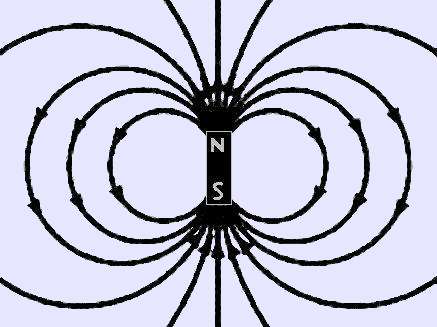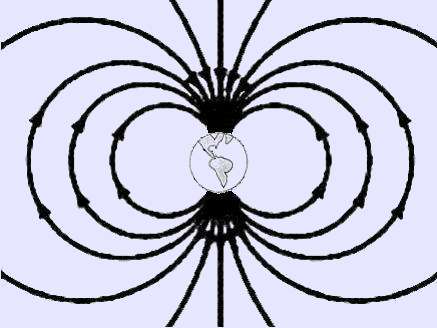Magnetic fields are historically described in terms of their effect on electric charges. A moving electric charge, such as an electron, will accelerate in the presence of a magnetic field, causing it to change velocity and its direction of travel. This is, for example, the principle used in televisions, computer monitors, and other devices with CRTs (cathode-ray tubes). In a CRT, electrons are emitted from a hot filament. A voltage difference pulls these electrons from the filament to the picture screen. Electromagnets surrounding the tube cause these electrons to change direction, so they hit different locations on the screen.
This is how it works: An electrically charged particle moving in a magnetic field will experience a force (known as the Lorentz force) pushing it in a direction perpendicular to the magnetic field and the direction of motion:

As a result of this force, the charged particle accelerates in the direction of the force (this is Newton's second law). In the diagram above the particle's trajectory will curve upward.
Magnetic fields are perhaps more easily understood in terms of magnetic field lines. Field lines, also known as lines of force, define the direction and strength of the magnetic field at any local in space.
As explained later, magnetic fields have both a direction and strength (or "magnitude"). The direction of the field lines indicates the direction of the field, while the density of the field lines indicates the magnitude of the field. Thus at points where the field lines are closer together, the field is stronger. Field lines are described mathematically with a quantity known as flux.Magnetic fields are commonly a result of magnetic dipoles. A simple example of a magnetic dipole is the bar magnet:

As you can see, the magnetic field lines always begin on the north pole of a magnet, and end on the south pole. This diagram illustrates the magnetic field lines of a typical magnetic dipole.
Magnetic dipoles always like to align themselves parallel to an external magnetic field, so the dipole's field matches the one applied to it. This is why bar magnets line up north-to-south. It also explains the behavior of a compass needle, which, being composed of Iron (a ferromagnet), behaves like a magnetic dipole.

This is sometimes an issue of confusion, but we are stuck with it. What we call "magnetic north" is really magnetic south.
To identify the north pole of a magnet, you can make a compass out of it. Either hang it on a string or float it on water. The pole that faces geographic north is the north pole. Once you have one magnet with poles identified, it is easy to label others, as like poles repel and opposite poles attract.
How strong is the magnetic field at a given distance from the magnet?Elementary physics states that the magnetic field of a magnetic dipole is approximately proportional to the inverse cube of the distance from the dipole. Therefore, if you double the distance from the magnet, the magnetic field strength will be reduced (roughly) by a factor of 8. How are magnetic fields measured?
The strength of a magnetic field is measured in units of Gauss (G), or alternatively, in Tesla (T). In the MKS (metric) system of units, 1 T = 1 kilogram*ampere/second^2 = 10^4 G.
For comparison, the magnetic field of the earth at the surface is on the order of 1 Gauss, where that of a Neodymium magnet is on the order of 10^4 Gauss. This means that Neodymium magnets produce magnetic fields tens of thousands of times stronger than those of the earth!
Technically, Gauss and Tesla are units of magnetic induction, also known as magnetic flux density. (This term is described in
an earlier question.) Quantitatively, the force on a charged particle q moving with velocity v is given by the vector equation F = qv x B, where B is the magnetic induction.Another common quantity of interest is the corecivity or corercive force of a magnet. Also measured in Gauss, the coercivity is the magnetic field required to demagnetize a material. For example, Neodymium magnets typically have a coercivity of about 12000 Gauss. Please note that the coercivity is the magnetic field required for de-magnetization. It is not actually a mesaure of the "strength" of the magnet, although the highly coercive magnets are usually quite strong.
The maximum energy product is used to determine the quality of magnetic materials. This is typically measured in Megagauss Oersted (MGOe - quite a mouthful!). The maximum energy product basically determines what materials make the best magnets.
Magnetic field strengths are measured with devices known as magnetometers.
Why are there so many odd units and terms used to describe magnetic fields? Keep in mind that magnetic fields appear any a large variety of contexts besides permanent magnets. Engineers and scientists regularly deal with magnetic fields in the study of electric circuits, motors, optics, and various other fields of technology. The power of the magnetic fields involved can vary a great deal, so many ways of measuring things have developed through the ages.
Magnetism and electricity are closely related phenomena. Electric charge is a fundamental property of matter. Matter is made up of electrons, neutrons, and protons. Electrons have a negative electric charge, while protons have a positive electric charge; neutrons have no electric charge. These tiny particles are the building blocks of atoms. An atom has a net positive electric charge when it loses one of its electrons, and a net negative electric charge when it gains an extra electron. On the other hand, magnetic charges do not exist - Magnetic fields are generated solely by moving electric charges.
An example of the relationship between electricity and magnetism is the motor. In a motor, a voltage is applied across the terminals of a coil of wire. The voltage causes the electrons in the wire to move, which in turn generates a current. This current results in a magnetic field, which interacts with permanent magnets attached to the core of the motor, causing it to move.
Another example of the relationship between magnetism and electricity is the
Lorentz force mentioned previously. Perhaps the most significant relationship between electricity and magnetism is light, which is known to physicists as an electromagnetic wave. Light waves are oscillating patterns of electric and magnetic fields, propagating through space at the speed of light (3x10^8 meters/second).Light is the best known example, but microwaves, radio waves, X-rays, infrared and ultraviolet light are also electromagnetic waves.
Electric and Magnetic phenomena are intricately described by a collection of physical laws, known as Maxwell's equations. Fully understanding these complex equations require a thorough knowledge of calculus and differential equations. For more information, take a course in electromagnetic theory from your local university. :-)
On the other hand, magnetic fields are directional. In a magnet, the magnetic field vector always points from the north pole to the south pole. In the space around the magnet, the vectors vary in both direction and magnitude. This is the behavior you see when you dump iron filings around a bar magnet, for example. Vector quantities which vary in space are known as fields; thus we have the term magnetic field for the vector field surrounding a magnet.
How does a permanent magnet work?Some materials have a feature known as ferromagnetism. The prefix "ferro" refers to Iron, which is one such material. Ferromagnetic materials have the ability to "remember" the magnetic fields they have been subjected to.
An atom consists of a number of negatively charged electrons, orbiting around a positively charged nucleus. These electrons also possess a quantity known as spin, which is roughly analogous to a spinning top. The combination of orbital and spin motions is called the angular momentum of the electron. Angular momentum is perhaps most easily understood in the case of the Earth: The earth spins about a central axis, which means it at has an angular momentum around that axis. The planets also have an angular momentum as they revolve about the sun.
Now, the angular momentum of an electron is a vector quantity, meaning it has direction. The motion of the electron produces a current, which in turn generates a tiny magnetic field in the direction given by the angular momentum. Thus an atom can behave like a dipole, meaning "two poles". The direction of the orbital and spin angular momentum of the electron determine the direction of the magnetic field for the electron and the entire atom, thus giving it "north" and "south" poles. Different atoms have different arrangements of electrons into their orbits, and thus have different angular momenta and dipolar properties.
A ferromagnetic material is composed of many microscopic magnets known as domains. Each domain is a region of the magnet, consisting of numerous atomic dipoles, all pointing in the same direction. A strong magnetic field will align the domains of a ferromagnet, or in other words, magnetize it. Once the magnetic field is removed, the domains will remain aligned, resulting in a permanent magnet. This effect is known as hysteresis.
Few materials are actually ferromagnetic; however, all substances have a diamagnetic nature. Diamagnetism means that the molecules within a substance will align themselves to an external magnetic field. The external magnetic field induces currents within the material, which in turn result in an internal magnetic field in the opposite direction. This effect is usually quite small and disappears when the external magnetic field is removed.
Some materials are paramagnetic. This is the case when the orbital and spin motions of the electrons in a material do not fully cancel each other, so that the individual atoms act like magnetic dipoles. These dipoles are randomly oriented, but will align themselves to an external magnetic field. However, when the field is removed, the material is no longer magnetized. Again, this effect is typically small. Neither diamagnetic nor paramagnetic materials exhibit magnetic domains.
The atomic behavior of magnetic materials is actually considerably more complicated than this, as it relies on the theory of quantum mechanics. Quantum mechanics is the theory of physics used to describe the behavior of tiny particles such as electrons; like electromagnetic theory, it is complex and involves advanced mathematics.
How does temperature affect the behavior of a permanent magnet?Ferromagnetic materials heated above a certain temperature, known as the Curie Temperature or Curie point, completely lose their ferromagnetic behavior. The magnetic domains within the magnet are actually generated when the material cools below the Curie point. The Curie temperature for Neodymium magnets is roughly 590 F.
Actually, the ferromagnetic properties of a material can change for temperatures well below the Curie temperature. Neodymium magnets, for example, begin to lose their magnetization at temperatures as low as 300 F.
What are Neodymium magnets made of?Not just Neodymium! Neodymium itself is actually a element number 60 on the periodic table. Neodymium magnets are actually made up of a compound called NIB, for Neodymium Iron Boron (Nd2Fe14B). This compound is one of the strongest known ferromagnetic materials.Click here for more information about the element Neodymium.
Click on the links below to check out our experiments with diamagnetic materials and superconductors (the links open new browser windows):
Diamagnetic levitation